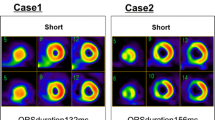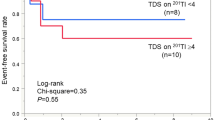Abstract
Objective
The objective of the study was to investigate the left ventricular (LV) myocardial perfusion and metabolism in patients with idiopathic dilated cardiomyopathy (DCM) and to identify the scintigraphic predictors of the efficacy of cardiac resynchronization therapy (CRT).
Methods
The study comprised 63 patients with DCM and severe heart failure (NYHA class III–IV). Before CRT, all patients received gamma-scintigraphy with 99mTc-methoxyisobutylisonitrile (99mTc-MIBI) and with 123I-β-methyl-iodophenyl pentadecanoic acid (123I-BMIPP) for evaluation of myocardial perfusion and metabolism, respectively. Before and after 6 months of CRT, all patients underwent echocardiography study to assess cardiac hemodynamics.
Results
After 6 months of CRT, patients were divided into two groups: group 1 comprised responders in whom LV end systolic volume (LVESV) decreased by ≥15 % (n = 39); group 2 comprised non-responders in whom LVESV decreased by <15 % (n = 24). Before CRT, LV pumping function did not significantly differ between groups. Significant differences were found in the following preoperative scintigraphic parameters: myocardial perfusion defect size [7.4 % (5.9; 13.2) % and 11.8 (8.8; 16.2) %, p < 0.05] and metabolic defect size [7.4 (4.4; 14.7) % and 8.8 (8.8; 17.6) %, p < 0.05]. Metabolic scintigraphy showed greater diagnostic efficacy in determining the indications for CRT compared with perfusion scintigraphy [areas under the ROC curves (AUC) of 0.722 and 0.612, respectively]. The best metabolic defect size threshold value of 7.35 % predicted CRT efficacy with the sensitivity and specificity rates of 77.8 and 66.7 %, respectively.
Conclusion
Data of metabolic scintigraphy may be useful for the integrated prediction of CRT efficacy.




Similar content being viewed by others
References
Manolio TA, Baughman KL, Rodeheffer R, Pearson TA, Bristow JD, Michels VV, et al. Prevalence and etiology of idiopathic dilated cardiomyopathy (summary of a National Heart, Lung, and Blood Institute workshop). Am J Cardiol. 1992;69:1458–66.
Abraham WT, Hayes DL. Cardiac resynchronization therapy for heart failure. Circulation. 2003;108:2596–603.
Bax JJ, Abraham T, Barold SS, Breithardt OA, Fung JW, Garrigue S, et al. Cardiac resynchronization therapy: part 2—issues during and after device implantation and unresolved questions. JACC. 2005;46(12):2168–82.
Sokolov AA, Marcinkevich GI. Electromechanical asynchrony and heart failure. Cardiol J. 2005;45(5):85–9.
Popov SV, Savenkova GM, Antonchenko IV. Effects of cardiac resynchronization therapy in the treatment of congestive heart failure. Sib J Med (Tomsk city). 2010;25(2–1):25–33.
Anagnostopoulos CD, Cokkinos DV. Prediction of left ventricular remodeling by radionuclide imaging. Eur J Nucl Med Mol Imaging. 2011;38(6):1120–3.
Lishmanov Y, Minin S, Efimova I, Chernov V, Saushkina Y, Lebedev D, et al. The possible role of nuclear imaging in assessment of the cardiac resynchronization therapy effectiveness in patients with moderate heart failure. Ann Nucl Med. 2013;27(4):378–85.
Hesse B, Tägil K, Cuocolo A, Anagnostopoulos C, Bardiés M, Bax J, et al. EANM/ESC procedural guidelines for myocardial perfusion imaging in nuclear cardiology. Eur J Nucl Med Mol Imaging. 2005;32(7):855–97.
Bleeker GB, Bax JJ, Fung JWH, van der Wall EE, Zhang Q, Schalij, et al. Clinical versus echocardiographic parameters to assess response to cardiac resynchronization therapy. Am J Cardiol. 2006;97:260–3.
Notabartolo D, Merlino JD, Smith AL, DeLurgio DB, Vera FV, Easley KA, et al. Usefulness of the peak velocity difference by tissue Doppler imaging technique as an effective predictor of response to cardiac resynchronization therapy. Am J Cardiol. 2004;94:817–20.
Yu CM, Chan YS, Zhang Q, Yip GWK, Chan CK, Kum LCC, et al. Benefits of cardiac resynchronization therapy for heart failure patients with narrow QRS complexes and coexisting systolic asynchrony by echocardiography. J Am Coll Cardiol. 2006;48:2251–7.
Chung ES, Leon AR, Tavazzi L, Sun JP, Nihoyannopoulos P, Merlino J, et al. Results of the predictors of response to CRT (PROSPECT) trial. Circulation. 2008;117(20):2608–16.
Cerqueira MD, Weissman NJ, Dilsizian V, Jacobs AK, Kaul S, Laskey WK, et al. Standardized myocardial segmentation and nomenclature for tomographic imaging of the heart: a statement for healthcare professionals from the cardiac imaging committee of the council on clinical cardiology of the American Heart Association. Circulation. 2002;105:539–42.
Germano G. Quantitative analysis in myocardial SPECT imaging. In: Zaidi H, editor. Quantitative analysis in nuclear medicine imaging. New York: Springer; 2006. p. 471–93.
Matsunari I, Fujino S, Taki J, Senma J, Aoyama T, Wakasugi T, et al. Impaired fatty acid uptake in ischemic but viable myocardium identified by thallium-201 reinjection. Am Heart J. 1996;131(3):458–65.
Lang RM, Bierig M, Devereux RB, Flachskampf FA, Foster E, Pellikka PA, et al. Recommendations for chamber quantification: a report from the American society of echocardiography’s guidelines and standards committee and the chamber quantification writing group, developed in conjunction with the European association of echocardiography, a branch of the european society of cardiology. J Am Soc Echocardiogr. 2005;18:1440–63.
Nikolaou K, Knez A, Rist C, Wintersperger BJ, Leber A, Johnson T, et al. Accuracy of 64-MDCT in the diagnosis of ischemic heart disease. AJR Am J Roentgenol. 2006;187(1):111–7.
Kudoh T, Tadamura E, Tamaki N, Hattori N, Inubushi M, Kubo S, et al. Iodinated free fatty acid and 201T1 uptake in chronically hypoperfused myocardium: histologic correlation study. J Nucl Med. 2000;41(2):293–6.
Satoh H, Sano M, Suwa K, Saitoh T, Nobuhara M, Saotome M, Urushida T, Katoh H, Hayashi H. Distribution of late gadolinium enhancement in various types of cardiomyopathies: significance in differential diagnosis, clinical features and prognosis. World J Cardiol. 2014;6(7):585–601.
Taki J, Nakajima K, Matsunari I, Bunko H, Takata S, Kawasuji M, et al. Assessment of improvement of myocardial fatty acid uptake and function after revascularization using iodine-123-BMIPP. J Nucl Med. 1997;38(10):1503–10.
Notabartolo D, Merlino JD, Smith AL, DeLurgio DB, Vera FV, Easley KA, et al. Usefulness of the peak velocity difference by tissue Doppler imaging technique as an effective predictor of response to cardiac resynchronization therapy. Am J Cardiol. 2004;94:817–20.
Stellbrink C, Breithardt OA, Franke A, Sack S, Bakker P, Auricchio A, PATH-CHF (PAcing THerapies in Congestive Heart Failure) investigators; CPI Guidant Congestive Heart Failure Research Group, et al. Impact of cardiac resynchronization therapy using hemodynamically optimized pacing on left ventricular remodeling in patients with congestive heart failure and ventricular conduction disturbances. J Am Coll Cardiol. 2001;38:1957–65.
Tanaka H, Nesser HJ, Buck T. Dyssynchrony by speckle-tracking echocardiography and response to cardiac resynchronization therapy: results of the Speckle Tracking and Resynchronization (STAR) study. Eur Heart J. 2010;31:1690–700.
Birnie D, de Kemp RA, Tang AS, Ruddy TD, Gollob MH, Guo A, et al. Reduced septal glucose metabolism predicts response to cardiac resynchronization therapy. J Nucl Cardiol. 2012;19(1):73–83.
Lehner S, Uebleis C, Schüßler F, Haug A, Kääb S, Bartenstein P, et al. The amount of viable and dyssynchronous myocardium is associated with response to cardiac resynchronization therapy: initial clinical results using multiparametric ECG-gated [18F] FDG PET. Eur J Nucl Med Mol Imaging. 2013;40(12):1876–83.
Acknowledgments
The study was supported by the Russian Science Foundation (Grant #14-15-00178). The authors thank Dr. Stanislav M. Minin, Ph.D., Senior Research Fellow of the Department of Nuclear Medicine, Federal State Budgetary Scientific Institution, Research Institute for Cardiology, for the methodological assistance and contribution to the generation of research material.
Author information
Authors and Affiliations
Corresponding author
Ethics declarations
Conflict of interest
The authors declare no conflict of interest.
Rights and permissions
About this article
Cite this article
Zavadovsky, K.V., Gulya, M.O., Lishmanov, Y.B. et al. Perfusion and metabolic scintigraphy with 123I-BMIPP in prognosis of cardiac resynchronization therapy in patients with dilated cardiomyopathy. Ann Nucl Med 30, 325–333 (2016). https://doi.org/10.1007/s12149-016-1064-0
Received:
Accepted:
Published:
Issue Date:
DOI: https://doi.org/10.1007/s12149-016-1064-0




